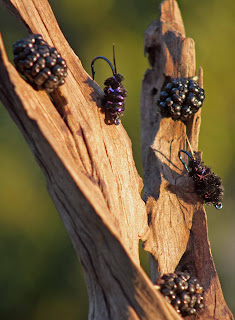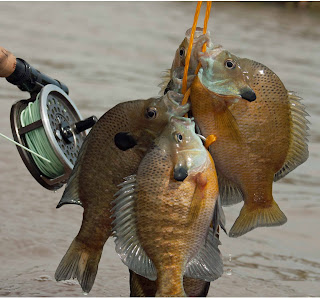It’s mid-July.
It’s HOT in southeast Nebraska and other parts of the
country.  |
| Mulberries on the bush. Dark purple and black berries are ripe. |
Days when the temperature tops out in the high-80s are a
welcome relief from other days when temperatures approach the three-digit mark.
The humidity reading is often almost identical to the temperature. It can be
hard to breathe as you shuffle from the air-conditioned car to the
air-conditioned house.
The old-timers call these “the dog days of summer,” when
heat from the sun drives the fish into cooler areas such as weed beds and stump
fields , deeper water, and shaded flowing water where there are cooler
temperatures. That makes the fish less active during daylight hours and the
spots where they go to avoid the sun and warmer temperatures more difficult for
the fly angler to fish.
That means the fish move to places where there is
protection from the direct rays of the sun, which makes the water cooler
(shade), where there is an acceptable level of oxygen in the water, and where
there are aquatic insects, small fish or other food sources. It also often
means they are hiding in submerged growing vegetation where the angler finds it
difficult to present a fly, or to fight the fish after a strike.
The “dog days” mean tough fishing.
But, late yesterday morning when I was taking Gabe, our
Chesapeake Bay Retriever, on a short walk in the pasture, slipping from the
shade of one tree to the next, I noticed the mulberry bushes growing near our
barn were still producing fruit. The branches were loaded with berries and the
ground beneath them was littered with dark purple and black mulberries.
“Mulberries!” I said out-loud, “It’s time to go carp
fishing!”
Gabe looked at me out of the corner of his eye, as if to
say, “Hey Boss, I do ducks, geese, pheasants, quail, maybe a dove or two, but I
draw the line at scales. You’re on your own on this one, buddy.”
If you’ve never caught a carp on your fly rod, you’re
missing some great action. Carp have kind of a bad reputation in this country
(more because of their social skills than their sporting qualities), but in
many other countries they are considered to be superior game fish.
I’m not going to go into all of the carp’s attributes
here, other than to say they are abundant in most areas of the country, they grow
to large size, fight well when hooked, and are great at the table after being
smoked, grilled, fried or baked.
During “the dog days,” carp are easy to find and aren’t
affected by the heat as are other species. One of my favorite ways to catch them
when nothing else will even look at my fly, is with mulberry flies.
 |
| Mulberry flies fool hungry carp. |
Mulberries grow along the banks of creeks, streams,
rivers, farm ponds and the quiet coves
of many lakes. The plant’s branches bend
and reach out over then water and ripe berries fall into the water where carp
often gather and suck them up.
When I’m fishing a creek, stream or river, I like to cast
into the current flowing along the bank above the mulberry bushes and let the
current carry my fly over feeding carp.
Carp don’t make dramatic strikes at the fly like a bass
or northern pike, instead it slowly sucks the fly into it’s soft mouth, feels
and mouths it a little and then leisurely turns and moves away. That’s when you should set the hook and be
prepared for a fight. A carp is best described as a “brawler”. Think late
nights at Irish pubs.
As I mentioned earlier, the carp is not known as
America’s most popular sport fish, but it is one scrappy fish well worth the
attention of warmwater fly angler.
Mulberry Fly
Hook -- Mustad 3367 #6 Thread -- Danville’s Black Flat Waxed Nylon
Body -- Medium Black Chenille
Rib – Purple Krystal Flash
Stem -- Black Goose Biot Fiber
